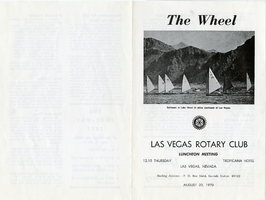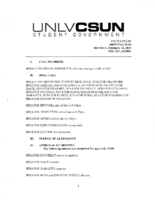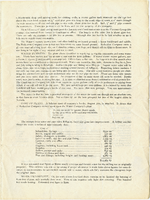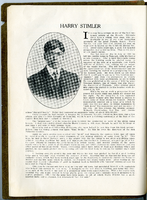Search the Special Collections and Archives Portal
Search Results

The Wheel Las Vegas Rotary Club newsletter, August 20, 1970
Date
Archival Collection
Description
Text

Meeting minutes for Consolidated Student Senate, University of Nevada, Las Vegas, February 14, 2005
Date
Archival Collection
Description
Text
Slavin Family Papers
Identifier
Abstract
The Slavin Family Papers (1905-1965) are materials related to Hale B. Slavin, a doctor who practiced in Las Vegas, Nevada from 1933 until his death in 1965, his wife Ruth Slavin, and his children, Thomas and Sarah Slavin. The collection includes memorabilia of events and commemorations, Hale B. Slavin's schoolwork from elementary through college, Thomas and Sarah Slavin's elementary school work, photographs, family correspondence, postcards, a diploma, and newspaper clippings.
Archival Collection

Peter Guzman interview, September 10, 2018: transcript
Date
Archival Collection
Description
Interviewed by Claytee White. Born in Florida, family arrived in Las Vegas in 1969. Father worked in the service industry. Worked as realtor before becoming President of the Latin Chamber of Commerce. Vice chairman of Hope for Prisoners and Vice Chairman of Workforce Connection.
Text

Transcript of interview with Adele Baratz by Claytee D. White, March 19, 2007
Date
Archival Collection
Description
Interview with Adele Baratz by Claytee White on March 19, 2007. In this interview, Baratz talks about her parents who came to the United States as teenagers from Russia and eventually settled in Las Vegas after a short time in California. She discusses the Jewish community in Las Vegas when she was growing up, and her father's job selling bootlegging supplies, then as a real estate broker, then as a bar owner. Baratz attended the Fifth Street Grammar School, which was built after a fire destroyed the original school, and Las Vegas High School. As a teenager, she worked at Nellis as a messenger and in the rations department, then went to nursing school in Baltimore at Sinai Hospital. She talks about her father's bar, "Al's Bar," that was popular with Union Pacific Railroad workers, and how the bar was forced out for the building of the Golden Nugget. Baratz recounts where her family lived, the growth of the Jewish community, and building the first synagogue on Carson Street.
Text

Transcript of interview with Nancy Houssels by Claytee D. White, March 19, 2014
Date
Archival Collection
Description
Text

Transcript of interview with Jonathan Sparer by Stefani Evans and Claytee White, August 29, 2016
Date
Archival Collection
Description
Text

Transcript of interview with Charlie Lombardo by David G. Schwartz, June 28, 2016
Date
Archival Collection
Description
Text


